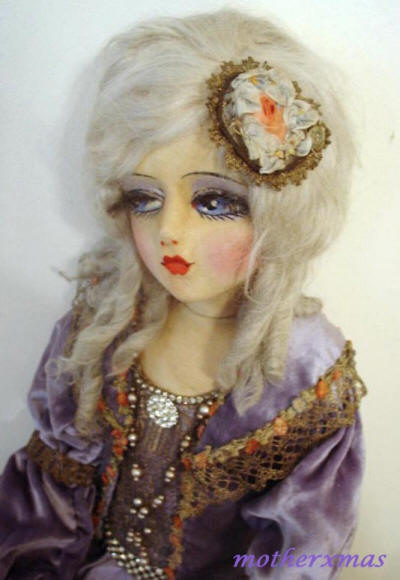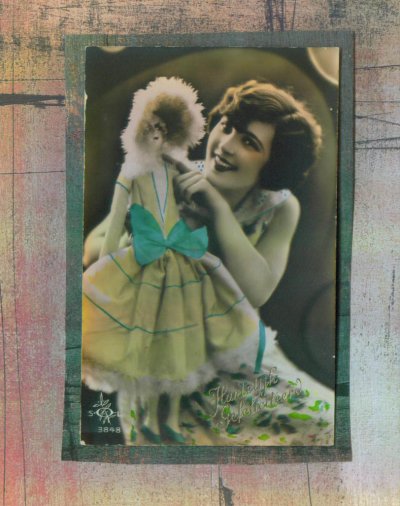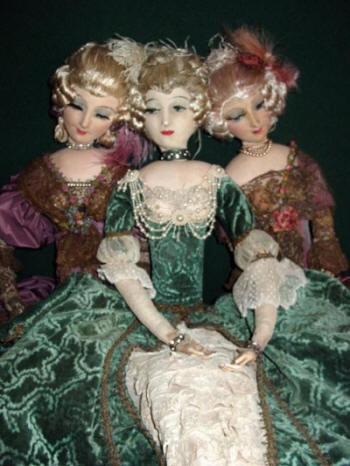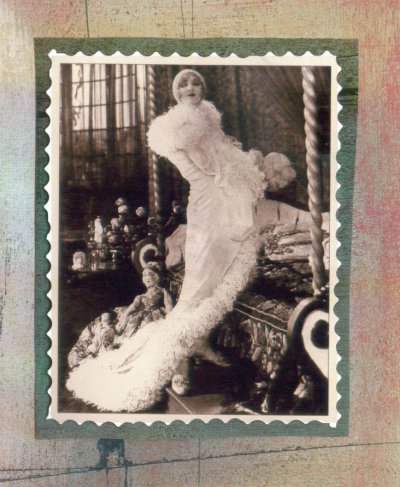|
|
boudoir doll
history |
|
What is it about boudoir dolls
that make them so controversial to so many people? You
would think that after being around for close to a
century that they would have become more respectable if
for no other reason but their longevity. Not so. The
amount of collectors of boudoir dolls compared to other
antique and vintage dolls is still a small segment in
the doll world. Although the collector circle is growing
, it is not uncommon to get blank stares when the
subject of boudoir dolls comes up.
It can be really frustrating to
serious collectors like myself, that these art deco
lovelies remain misunderstood. There was a time, right
after World War 1, that boudoir dolls were all the rage
and symbolized many of the new found freedoms American
women were experiencing for the first time. Having
gained the right to vote women explored new options in
fashion, education, employment and sexual conduct. With
the coming of the "jazz age" women were shedding their
sheltered demure Edwardian persona in exchange for a
new, adventurous , modern style. Gone was the long hair,
layers of clothing and high boots. Modern women favored
bobbed hair, simple loose dresses, flat shoes and rouged
knees. Embracing the "flapper" image, it was fun to
break a few rules and dance the Charleston all night. A
time to party, smoke, drink and experience life in the
fast lane. It became acceptable to look naughty, but
with the double standard still in place, promiscuity was
not necessarily part of the equation.
|
|
 |
|
In private, women began to dream
of a more adventurous life filled with fantasies that
were fueled by the magic of the movies and dreams they
evoked. The lure of the movies was addictive and the
very naïve American public became enchanted with the
seemingly exciting and romantic lives of their favorite
screen stars.
In the boudoir doll women saw the
personification of the glamorous actresses and wanted to
bring a little of that vicarious excitement into their
own lives. Here was a doll that represented all that was
titillating and taboo and could be proudly displayed in
their home particularly in the bedroom. The dolls were
very tactile to the touch, so it easy to imagine a
flapper enjoying playing , posing, cuddling and
whispering secrets to her boudoir pal. There still
existing many French postcards featuring vamps and their
dolls. It is also interesting to note that many movies
of the 1920’s and the 1930’s included the dolls as part
of the boudoir décor of so called loose women. One
wonders if this sexual connotation is the reason the
dolls were considered trashy for so long.

When boudoir dolls were first introduced in Europe they
were considered to be art dolls, salon dolls and
sometimes French dolls. Although French designer Paul Poiret is credited for starting the boudoir doll fad,
the first dolls that were commercially available were
found at a trade show in France that was part of the
recovery process after WW1. It is documented in a French
magazine called Femmina and reports of a special
exhibit, in Paris, of Russian handicrafts created by
aristocratic émigrés . The writer was impressed by the
quality and taste level of the products shown. An item
of particular interest was the stylized rag dolls
dressed in traditional costume and referred to as a new
craft. Similar creations were also being found in
Germany and Italy as artistic types tried their hand at
crafting dolls and other items as a means for survival.
It was the dolls that captured the public fancy and
would continue to do so for two decades.
|
 |
|
Early boudoir dolls were
often dressed in theatrical, historical,
regional, or harem looks. The heads and bodies
of the earliest cloth dolls are often crudely
made with exquisite attention given to the
costume detail. The elongated shapes of the doll
mimicked the styles of advertising and fashion.
The doll artists went for a stylized rather than
a realistic appearance.
Many of the earliest dolls
are considered the most artistic , to serious
collectors, as these were part of a grand
experiment to see what would most appeal to the
public. While most designers would stay within
the safe parameters previously mentioned. Others
pushed the boundaries of propriety and created
characters right out of the seedier side of
life. Among these are some of the first smoking
dolls depicting apache dancers, street ruffians,
and "la garconne" women dressed in men’s
clothes. It has been alluded that it isn’t
always tobacco that is being smoked.
|
|
|
|
Although most of Europe was
struggling with the recovery, the economy in America was
booming but Prohibition was in effect. Wealthy travelers
and thrill seekers looked to Europe as the continental
playground for the privileged. Millionaires, movie
stars, and bohemians crossed the Atlantic for adventure,
sexual freedom and legal booze. Charmed by these new
dolls many young stars returned to the states with
armloads of the exotic beauties. They were often
photographed holding these dolls and their fans wanted
to share in the fun.
By the mid 1920’s New York City
manufacturers took notice of the growing art doll market
and decided develop their own brand of these
sophisticated rag dolls. The European boudoir doll would
be transformed into a doll that would conform to the
beauty standards of the public. She would be
Americanized and begin to resemble popular silent movie
stars. What was once considered an art doll would be
transformed first into a flapper and eventually a
decorative bed doll. The metamorphosis would take about
fifteen years until the eventual oblivion of boudoir
dolls in the 1940’s. The appeal of boudoir dolls lost
its allure after the Second World War and many of them
were either thrown away or safely packed for sentimental
reasons. They would be discovered for a short time in
the 1970’s but not given any serious attention until the
1990’s when collectors would start to recognize these
relics from the Jazz Age as icons of a lost generation.
So take a moment to savior and
reflect the history of these unusual dolls. They are a
unique mirror into the twentieth century history and a
past that has been long forgotten. Now is the time to
remember our roots and realize these dolls should not be
thought of as a frivolous fad but a touchstone to
another era.

All contents, graphics,
text, photos, features
and general information, contained on this website
are the personal property of Patricia Brill aka MotherXmas.
Therefore, no unauthorized copying and/or use without written
consent.
© 2008-2024 Patricia Brill aka MotherXmas
|
|
|
|
|